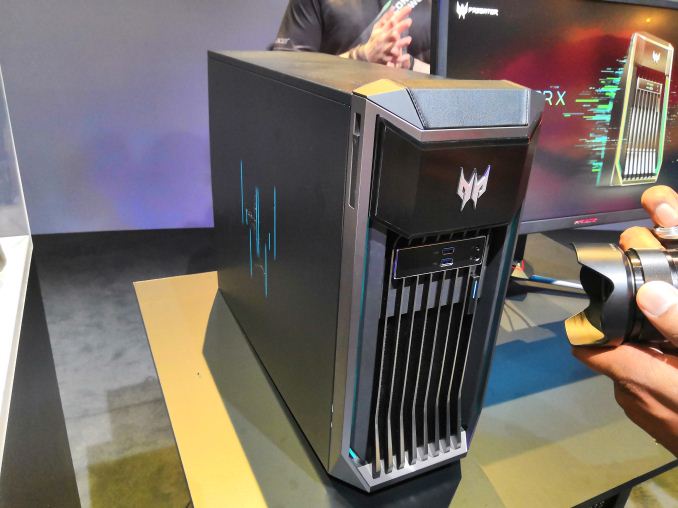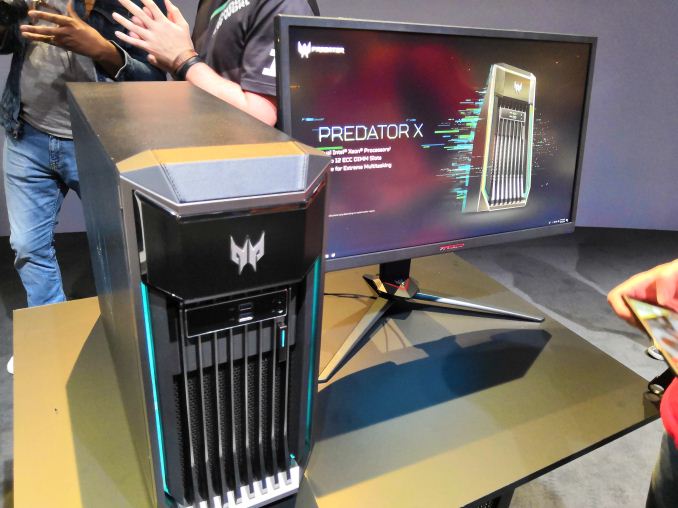Acer Wants To Sell a Dual Xeon Predator X System: Please No
by Ian Cutress on August 29, 2018 6:10 AM EST- Posted in
- desktops
- Gaming
- Acer
- Xeon
- Workstation
- Trade Shows
- NVIDIA
- Predator
- IFA 2018
- Predator X

Acer’s leading gaming branding, Predator, is all about maximizing performance, particularly around gaming. In the modern era, that now extends into content creation, streaming, video editing, and all the sorts of things that drive the need for high performance. As we’ve seen several times over the years, just throwing more cores at the problem isn’t the solution: bottlenecks appear elsewhere in the system. Despite this, Acer is preparing a mind-boggling solution.
The Acer Predator X is the new dual-Xeon workstation, with ECC memory and multiple graphics cards, announced today at IFA 2018. The premise of the system is for the multi-taskers that do everything: gaming, content creation, streaming, the lot. With this being one of Acer’s flagship products, we expect it to be geared to the hilt: maximum cores, maximum capacity. There-in lies the first rub: if Acer is going all out, this is going to cost something crazy:
- 2 x Intel Xeon 8180 ($10009 x 2)
- 12 x 16 GB ECC RDIMM ($200 x 12)
- 2 x NVIDIA Quadro RTX 8000 ($000s x 2)
- Some Storage
- Some big power supply
- Some custom chassis
Of course, Acer is focusing this product for the next generation of processors (read, Cascade Lake-SP), and so none of the specifications have been put into place yet. However, there’s a fundamental aspect to dual-CPU systems that needs to be addressed.
Dual CPU systems have what is known as a Non-Uniform Memory Architecture (NUMA) – despite each CPU having direct access to memory, without a NUMA-aware operating system or software in place, memory for one process on one CPU can be allocated on the memory of the other CPU, causing additional latency. We tested this way back in 2013, and the situation has not improved since. Most software assumes all the cores and memory are identical, so adding additional latency causes performance to tank. Tank hard.
Back in those 2013 articles, even scientific software was not built for multi-CPU hardware, and often performed worse than a single CPU with fewer cores. More recently, we’ve seen even single socket systems with a NUMA like environment such as the 32-core Threadripper 2 show performance deficits against monolithic solutions. Only in very specific scenarios (lightweight ray-tracing being the best), does performance improve.
When I approached the person who Acer put on stage to promote this new hardware for the Predator brand about these issues, he didn’t really have a clue what I was talking about. At first he confused it with having ECC, and describing the difference between bandwidth and latency seemed to go no-where. If Acer wants to promote this as a Windows machine, which I’m 99.9% sure they will, they really need to have some software wrapper in place to enumerate cores and put Core Affinity in place. Otherwise people will shell out a lot of money for, in a lot of cases, worse performance.
But hey, maybe Acer is going after the VM gaming market? Right?
One thing I was told is that Acer will be offering configurable variants. So you might be able to use a pair of Xeon Silver instead. Or remove that piece of 'leather' from the front of the chassis.


















37 Comments
View All Comments
darcotech - Wednesday, August 29, 2018 - link
Then you do not know the power of brainless with deeeep pockets.That is their target. Leather is the best proof.
ImSpartacus - Wednesday, August 29, 2018 - link
Aren't the RTX 8000s $10k each?https://www.anandtech.com/show/13217/nvidia-announ...
Dug - Wednesday, August 29, 2018 - link
That case!!! That's what dreams are made of.MrSpadge - Wednesday, August 29, 2018 - link
You mean nightmares?GreenReaper - Wednesday, August 29, 2018 - link
NUMA can be a real issue, but the level of that impact depends in part on the OS and app. For example, AnandTech saw more of an impact than Phoronix as it tests on Windows, not Linux:https://www.phoronix.com/vr.php?view=26716
https://www.phoronix.com/vr.php?view=26705
https://www.phoronix.com/scan.php?page=article&...
This system is one of the few where it is likely to be a big issue, as most consumers run Windows. But if anything, the presence of such systems might kick Microsoft (and perhaps even game engine devs) into improving their NUMA handling by the time Cascade Lake-SP comes out.
MrSpadge - Wednesday, August 29, 2018 - link
"they really need to have some software wrapper in place to enumerate cores and put Core Affinity in place"Process Lasso can already do this on the fly. However, it's a bit cumbersome to find and set optimal configurations for different programs (i.e. steam library).
twtech - Wednesday, August 29, 2018 - link
There are some other uses for these systems besides just ray-tracing. Dual CPU systems are pretty standard issue for programmers in game development for example, but that may no longer be necessary in the future with more high core count, high-clockspeed processors available.I'm interested to see how high Intel can push the frequency on their 28-core i9, and the Zen 2 Epycs should be interesting as well next year.
The problem with the 32-core TR2 right now is that the indirect access to memory is killing performance in a lot of tasks - including code compiling on Windows - and that is a deal-breaker for my use-case.
HollyDOL - Thursday, August 30, 2018 - link
Well, in gaming (or generally GPU coding) you rather need dual gpu... when you start debugging shaders, your card can hardly render visual studio (at least it was the case a while back)... one of few places where iGPU comes handy.But dual CPU... what for?
RSAUser - Friday, August 31, 2018 - link
Assuming to allow hot loading or something like that? Keep game on one CPU, run the rest of it on the other including compiling, with e.g. unreal engine detecting the newly compiled dll.Santoval - Wednesday, August 29, 2018 - link
Content creators largely avoid Windows for the reasons you described. Games largely avoid Linux because it has few native AAA games and the rest need to be run via Wine, its recent Proton fork by Valve or a virtual machine, with a performance loss.Windows has crappy NUMA support (which is what you imply but do not directly state here), and of course I am talking about its more premium versions, including Windows Server, not... Home. Linux and the various flavors of BSD have great NUMA support in all their versions*.
So a machine like that from Acer cannot have it both ways. They will either lose gamers or content creators, but cannot satisfy both with a single machine and a single OS.
*Michael Larabel at Phoronix ran a benchmark a few days ago comparing Threadripper 2990WX under Linux (Ubuntu 18.4., i.e. a "Windows Home" Linux equivalent) versus the latest Windows Server. The benchmark used many CCX variations and active core counts of 2900WX, from 4 cores to 32 cores. Windows Server was decimated in all of them.